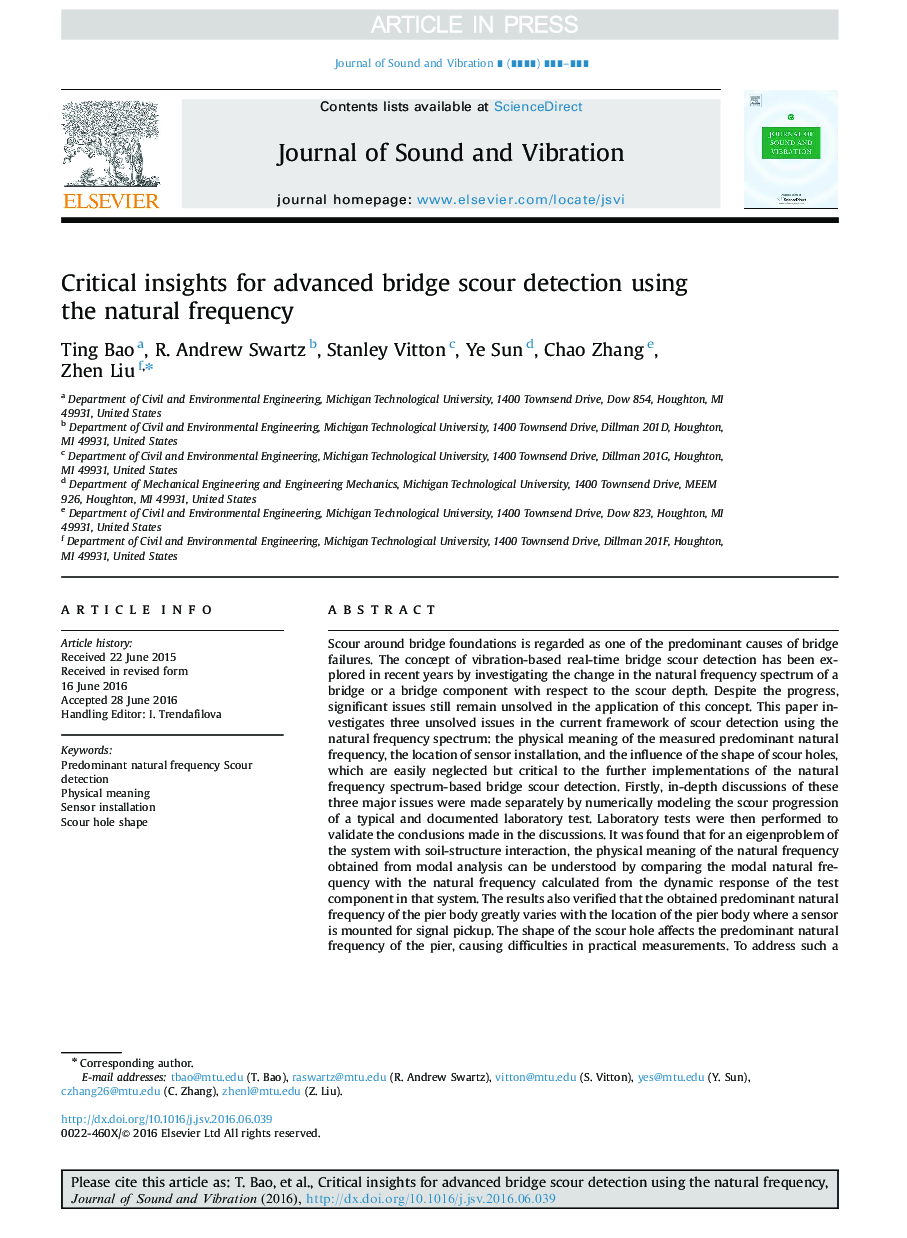| کد مقاله | کد نشریه | سال انتشار | مقاله انگلیسی | نسخه تمام متن |
|---|---|---|---|---|
| 4924548 | 1430847 | 2017 | 18 صفحه PDF | دانلود رایگان |
عنوان انگلیسی مقاله ISI
Critical insights for advanced bridge scour detection using the natural frequency
ترجمه فارسی عنوان
بینش انتقادی برای تشخیص پیشرفته پل معلق با استفاده از فرکانس طبیعی
دانلود مقاله + سفارش ترجمه
دانلود مقاله ISI انگلیسی
رایگان برای ایرانیان
کلمات کلیدی
ترجمه چکیده
گرد و خاک در اطراف پایه پل به عنوان یکی از علل غالب شکست پل است. مفهوم شناسایی پل معلق در زمان واقعی مبتنی بر ارتعاش در سال های اخیر با بررسی تغییرات طیف فرکانس طبیعی یک پل یا یک جزء پل با توجه به عمق آبشاری مورد بررسی قرار گرفته است. با وجود پیشرفت، مسائل مهم هنوز در استفاده از این مفهوم حل نشده است. در این مقاله سه مسأله حل نشده در چارچوب فعلی تشخیص آستانه با استفاده از طیف فرکانس طبیعی بررسی می شود: معنای فیزیکی فرکانس غالب طبیعی، محل نصب سنسور و تاثیر شکل سوراخ های شستشو که به راحتی قابل چشم پوشی نیست اما برای پیاده سازی های بعدی از تشخیص قطعه قطعه بر پایه طیف فرکانسی طبیعی ضروری است. اولا، بحث های عمیق در مورد این سه مسأله اصلی به طور جداگانه با استفاده از مدل سازی عددی پیشرفت بیهوشی یک آزمون آزمایشگاهی معمول و مستند ساخته شد. سپس آزمایشات آزمایشگاهی برای تأیید نتیجه گیری های انجام شده در بحث انجام شد. مشخص شد که برای یک مسئله اصلی سیستم با تعامل ساختار خاک، معنای فیزیکی فرکانس طبیعی حاصل از تحلیل مودال می تواند با مقایسه فرکانس طبیعی مودال با فرکانس طبیعی محاسبه شده از پاسخ دینامیکی مولفه تست در این سیستم. نتایج همچنین نشان داده است که فرکانس طبیعی غالب طبیعی بدنه ی اسکله به شدت با محل اسکله که در آن یک سنسور برای دریافت سیگنال نصب شده است، متفاوت است. شکل سوراخ شستشو بر فرکانس غالب طبیعی اسکله تأثیر میگذارد که باعث بروز مشکلات در اندازهگیریهای عملی میشود. برای مقابله با چنین مشکل، یک معیار جدید برای شناسایی عمق حفره های نامتقارن شستشو برای اولین بار پیشنهاد شده است، که از اهمیت عملی برای پیشرفت چارچوب تشخیص چالش مبتنی بر طیف فرکانس طبیعی است.
موضوعات مرتبط
مهندسی و علوم پایه
سایر رشته های مهندسی
مهندسی عمران و سازه
چکیده انگلیسی
Scour around bridge foundations is regarded as one of the predominant causes of bridge failures. The concept of vibration-based real-time bridge scour detection has been explored in recent years by investigating the change in the natural frequency spectrum of a bridge or a bridge component with respect to the scour depth. Despite the progress, significant issues still remain unsolved in the application of this concept. This paper investigates three unsolved issues in the current framework of scour detection using the natural frequency spectrum: the physical meaning of the measured predominant natural frequency, the location of sensor installation, and the influence of the shape of scour holes, which are easily neglected but critical to the further implementations of the natural frequency spectrum-based bridge scour detection. Firstly, in-depth discussions of these three major issues were made separately by numerically modeling the scour progression of a typical and documented laboratory test. Laboratory tests were then performed to validate the conclusions made in the discussions. It was found that for an eigenproblem of the system with soil-structure interaction, the physical meaning of the natural frequency obtained from modal analysis can be understood by comparing the modal natural frequency with the natural frequency calculated from the dynamic response of the test component in that system. The results also verified that the obtained predominant natural frequency of the pier body greatly varies with the location of the pier body where a sensor is mounted for signal pickup. The shape of the scour hole affects the predominant natural frequency of the pier, causing difficulties in practical measurements. To address such a problem, a new criterion was proposed to identify the depth of unsymmetrical scour holes for the first time, which is of practical significance to advance the natural frequency spectrum-based scour detection framework.
ناشر
Database: Elsevier - ScienceDirect (ساینس دایرکت)
Journal: Journal of Sound and Vibration - Volume 386, 6 January 2017, Pages 116-133
Journal: Journal of Sound and Vibration - Volume 386, 6 January 2017, Pages 116-133
نویسندگان
Ting Bao, R. Andrew Swartz, Stanley Vitton, Ye Sun, Chao Zhang, Zhen Liu,
